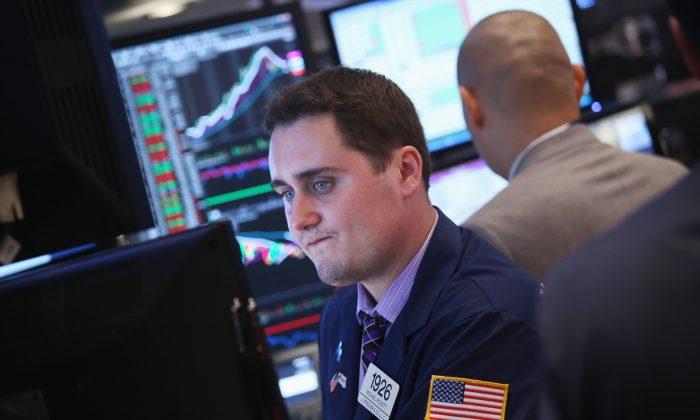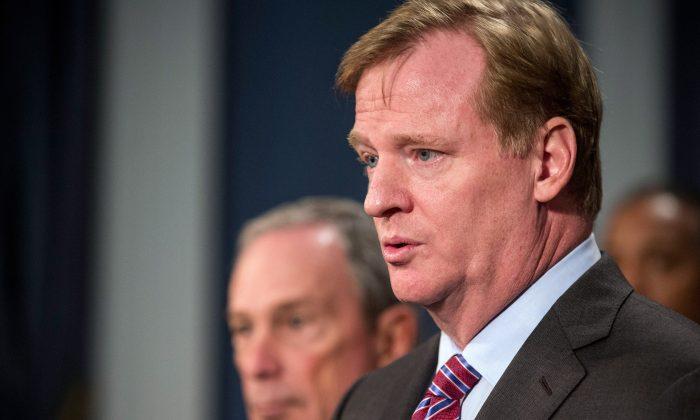The U.S. markets plunged Sept. 20 on heavy volume as financial markets became unsettled following a week of mixed signals from the Federal Reserve.
The Fed, in a surprising move, announced last Wednesday that it would continue its $85 billion per month bond purchase program, dubbed quantitative easing (QE3). Economist and NYU Professor Nouriel Roubini was probably the only person who expected the Fed to stand pat, tweeting before the FOMC announcement, “Based on the US macro-economic data, the Federal Reserve should not, and may not, taper.”
In May, Chairman Ben Bernanke initially hinted at a gradual taper of QE3. Economists, Wall Street analysts, and investors expected an initial taper of around $10 billion per month in September as recent employment and housing market readings indicate that the economic recovery is on solid footing.
As U.S. stocks had priced in the expected taper, last Wednesday’s move left the markets unprepared. The market correction was immediate—the Dow rose 90 points in 30 seconds following the announcement that loose monetary policy was staying for a bit longer. Yields on 10-year treasuries dropped 18 basis points on Sept 18 and mortgage rates declined moderately.
“The Fed completely shocked markets today on a variety of fronts—not only was the $85Bn kept in place but the forward guidance framework saw material dovish adjustments during the Bernanke press conference,” JPMorgan analysts wrote last Wednesday in a research note to clients.
Article Continues after the discussion. Vote and comment
[tok id=bed3867915f6672a9b690d179d6719f3 partner=1966]
The Fed based the decision on its assessment that the U.S. economic recovery wasn’t convincing enough to warrant a tightening of monetary policy. Inflation remains far below target, and unemployment rate—despite its steady decline—remains elevated. Bernanke initially said that an official unemployment rate of 7 percent would signal that the economy was healthy enough, but more recently backed away from that threshold.
Keeping the Market Guessing
Despite the more-dovish-than-expected tone of the FOMC announcement last week, subsequent speeches by a few Federal Reserve Presidents offered some conflicting signals to the markets.
Two indicators to watch are unemployment figures and payroll data released by the Department of Labor. “To the extent that these two important labor market indicators continue to show improvement, the likelihood of tapering policy action will continue to rise,” St. Louis Federal Reserve President James Bullard said in prepared remarks to the New York Association for Business Economics.
In an interview on Bloomberg TV on Sept. 20, Mr. Bullard said that the Fed could taper its bond-purchasing at its next meeting in late October, if economic signals are strong enough.
Separately, Kansas City Federal Reserve President Esther George suggested on Friday that tapering the Fed’s asset purchasing should have already happened. Ms. George had been a vocal critic of QE3 and was the lone dissenter at last week’s FOMC meeting who voted in favor of tapering.
“Over the past 12 months, the unemployment rate has dropped a bit more than one-half of a percentage point and the economy has added more than 2 million jobs. At this pace of improvement, the labor market is creating enough jobs to continue bringing down the unemployment rate,” Ms. George said in a speech in Omaha on Sept. 20. “I have been more skeptical than the majority of the [FOMC] that the benefits of continued easing through unconventional policy actions justify the risks, particularly when the economy is growing and financial markets are not under acute stress.”
Ms. George suggests that $70 billion per month in bond purchases is a reasonable course of action.
The stock market declined last Friday while digesting the new uncertainty surrounding the Fed’s guidance. The Dow Jones Industrial Average dropped 185.5 points, the S&P 500 Index fell 12.5 points, and the Nasdaq Composite ended the day 14.7 points lower.
“The Fed wants everyone to speak their minds to show that the governors, officials within the Fed all have differing opinions, that there isn’t a unifying voice,” said Timothy Ghriskey, co-founder of Solaris Asset Management, according to a Reuters report.
Sept. 20 was also “quadruple witching” day, meaning stock futures and options and index futures and options all expire on the same day. The day brought heavier-than-normal volume to the markets as traders looked to roll those contracts.
Uncertainties Lie Ahead
The Fed’s decision last week is an indication that while the central bank will remain flexible going forward, they’ll also keep market observers guessing.
“We now expect the QE tapering process to start at the December 2013 FOMC meeting,” Goldman Sachs’ Chief Economist Jan Hatzius wrote in a research note to client on Sept. 19. “Our working assumption is a $10bn step-down in the pace of Treasury purchases, with no change in MBS (mortgage-backed securities) purchases.”
In addition, Goldman suggested that the new 6.5 percent unemployment threshold for Fed action is contingent on near-term inflation reaching 2 percent, which is hardly a guarantee.
Citigroup agrees that December is a reasonable target to begin tapering. “With the exception of a problematic political hurdle to tapering, we don’t think economic and financial conditions would warrant peak accommodation beyond year-end,” Citigroup wrote in a note to clients Sept. 20. The bank also says that labor market improvements are hard to judge, especially given its volatility and the “ongoing debates about cyclical versus structural forces in play.”
Paul Schatz, the chief investment officer at Heritage Capital LLC, told CNBC on Sept. 20 that he expects the stock market to fall drastically over the next two to three weeks and bonds to rebound given its recent decline in anticipation to the QE3 taper.
Just about the only thing analysts can agree upon is that the Fed’s lack of guidance coupled with a looming government debt ceiling fight will increase market volatility.
Frank Yu is a contributor to the Epoch Times.





Friends Read Free